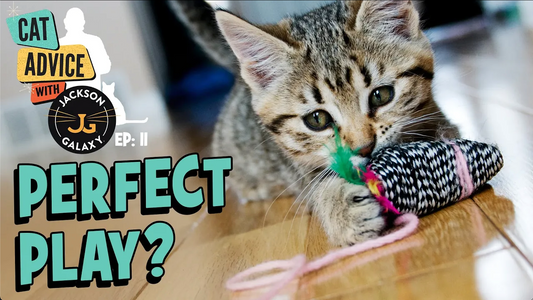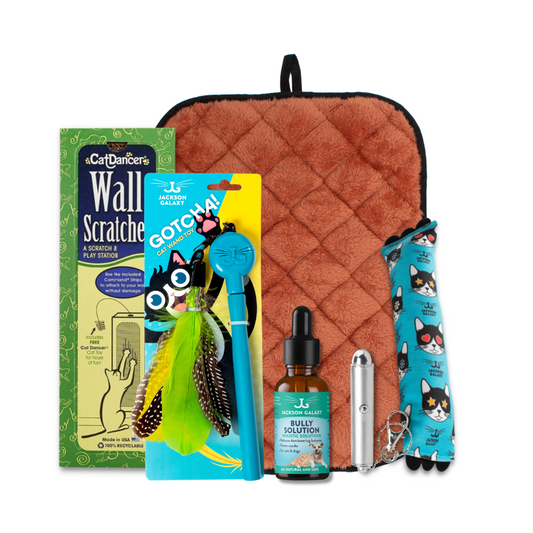In my experience, bringing a new cat into another cat’s home can either be seen as no big deal, or a huge challenge. The truth, however, generally lies somewhere in the middle. In this series, we will explore the critical ins-and-outs of making this transition as smooth as possible for all involved—both feline and human!
Episode One: Before the Introductions
Cat Mojo is largely based around territorial security. So when you bring a new cat into another cat’s home, it can be a complicated affair, based on two x-factors: Your existing cat’s sense of that security—since a new cat has joined the mix—and the newcomer’s, as they attempt to get comfortable in a completely new environment... with another cat.
This is why the old common wisdom of introducing cats by “letting them work it out” is not only a recipe for disaster, but it also feeds the belief that cats are solitary creatures who are better left that way. In essence, it’s cat Russian Roulette; they will actually work it out sometimes, but when it doesn’t work, you are triggering the territorial panic switch in your existing cat... which means war. Remember: we are taking an in-depth process, but asking cats to do this in a relatively small, closed territory. This can make the process even trickier.
With this in mind, I present to you the exact step-by-step introduction strategy I have personally used through the years; a time-tested recipe for successful integration that I’ve seen in action hundreds of times. Be prepared to follow this process to a T, while embracing the slow-and-steady-wins-the-race mantra. Not only are we trying to minimize risks, preventing a long-term lack of trust between the cats, but we also try to go slow to ensure a stronger bond of friendship.
At the same time, understand that this is definitely not a one-size-fits-all situation. Every introduction unfolds in its own way, and on its own time. Exactly how slow you take things will, of course, depend on how amenable your cats appear to be with this new living arrangement. If things are moving forward harmoniously, then feel free to breeze through the steps—so long as you don’t actually skip any. I have put things in a specific order for very specific reasons.
Ready? Set? Let’s go! ––––––––  Step One: Proactive Preparation –
Step One: Proactive Preparation –
Crucial Things to Do Before You Bring Your New Cat Home
Before you can make that new dish, you have to get all the ingredients together. The same could be said for our cat-to-cat introduction protocol. Here are three fundamental steps to accomplish that will give you a significant leg up on the process:
1. No More Free Feeding
Make sure you have switched your existing cat over to a routine of meal feeding, rather than free feeding her. If you don’t know by now, this concept is foundational to my approach, because cats are not motivated by our desires; they are motivated by their own… and one of those major motivations is food. This is to say, if your cat’s not hungry, good luck getting them to do anything you want them to do. Therefore, nowhere else is this “food as leverage” concept more important than during the introduction process, as we’ll discuss soon enough.
2. Proactive Catification
Here is where we will customize and integrate some key Catification ideas. What is Catification, you ask? Catification is the art of creating an enriched environment that is acceptable to both you and your cat. Catification teaches us that every square inch of the home can be shared in a positive way. Allowing our cats to own spaces through scent distribution and finding confidence in the vertical world can be accomplished—all while respecting and adhering to our own personal aesthetics.
Specifically, here are a few ways we can proactively use Catification to prepare for the newcomer:
A. “Childproofing:” Before bringing home a new baby, you probably will have thought a few steps ahead to when he or she is more mobile and heading into the world of potential booby traps. Initially your new cat family member will be sequestered, but it’s never too early to cat-proof. One difference, though: preventive measures for a solo cat might concentrate more heavily on child locks on cabinets, burner and knob covers on the stove, etc. Of course, that should be done regardless, but for integration, things like blocking off the Unders (Cat Daddy term for “under” the bed, “under” the TV stand, or basically “under” anywhere) is more of a priority. If you’ve ever tried to break up a cat fight under a bed, you’ll know exactly why this is so important! So, think about where potential ambushes could occur, or where a scared cat might burrow away, not to be seen for days on end…and then catify!
B. Territorial Diversity: The way cats perceive territory is floor to ceiling, 360 degrees. If you have the choice, you want to bring a new cat to a home where the “top is popped.” You’ve made it as territorially diverse as possible, so that when the cats do come into contact, it can be done at a safe distance, with each cat finding his or her Confident Where (Cat Daddy term for that spot on the vertical axis where your cat is their most confident self). Therefore, when you’re Catifying for a new arrival, you want to make sure you’re building the bare bones—a territorial skeleton, if you will—where you’re giving equal emphasis to different spots on the vertical axis. This is because you don’t know who this new cat’s going to be, but you want to give her the ability to find her Confident Where somewhere, giving you the ability to build out her surroundings as you get to know her better.
C. Urban Planning in Action: Speaking of the Confident Where (and the territorial skeleton), introduction time is prime time to make sure you maximize traffic flow, which will, in turn, decrease the conflict that can come with traffic jams. Consider this:
- Building a Cat Superhighway around the most crucial social space—usually the living room or the bedroom—is a key Catification element. The Superhighway creates multiple lanes of traffic, with various on and off ramps, using design elements like shelving, cat trees, and window beds, to provide vertical breathing room.
- As the superhighway takes care of the sky, tunnels and cocoons help catify the floor… along with litter box placement that prevents ambush and doesn’t create dead ends.
Urban planning maximizes the potential for discovery, time-sharing, and space-sharing required for cats to get to know each other, and makes the whole transitional period as noncompetitive as possible.
3. Establish a Separate Base Camp
Base camp is a defined area of your home that is the heart of your cat’s territory. It is a place of safety and familiarity. Base camp should be a room that you spend time in: a socially meaningful space where you can mingle your scent with your cat’s. Here are your moves:
A. Set Up Base Camp: Decide where you’re going to set up base camp for the new cat. This could be the master or a spare bedroom, an office, or even the bathroom when there is no other option. As long as the human scent is strong, it will help the cat establish a sense of home by comingling scents. All cats need a place where their Mojo can bloom… and this is precisely what we are establishing for your new family member.
Conversely, a laundry room, garage, or basement is not a great place to set up base camp, since these are not rooms you likely want to spend a lot of time in, and they probably don’t smell strongly of you.
Note: You may not want your master bedroom to be the new cat’s base camp. If your resident cats sleep with you, you don’t want to kick them out of that “home within the home.” No place smells more like you than your bed. You might be setting up your cats for a rocky start.
Here are a couple base camp staples:
B. Integrate Signposts: These are objects that signify territorial ownership for your cat. By definition, a signpost is something your cat has left a visual sign or scent on, such as scratching posts, litter boxes, and cat beds.
C. Integrate scent soakers: These are soft items that absorb a cat’s scent, and can also serve as a signpost. They say “I live here,” and allow for rubbing, scratching, or lying in. Beds, blankets, carpets, cardboard scratchers, and scratching posts are all excellent scent soakers.
Although this proactive preparation part of the process might seem a bit lengthy and involved, remember: you have only one chance to make a first impression, right? Your investment into this prep time will pay big dividends later.
You are now ready to bring your new cat home. In Episode Two, we’ll get into all the details of this critical second step.
Even though this series might seem in depth, you ain’t seen nothing yet! There is actually much more to be found in the chapter that this has been excerpted from in my new book, Total Cat Mojo.












